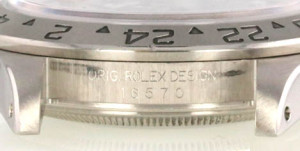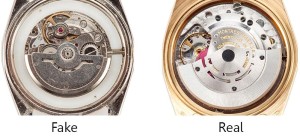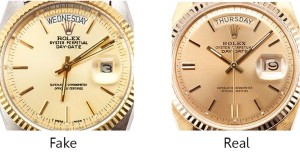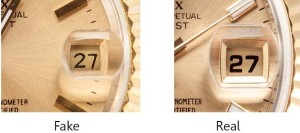The generic watch market continues to grow and become more efficient, making counterfeit luxury timepieces more and more difficult to tell apart from their genuine counterparts. Given the difference in value between replica Rolexes and the genuine article, any potential investor should know the tricks to tell the real from the fake. Here’s a quick list of some of the ways to tell apart the genuine luxury watch and its cheaper knock-offs.
Serial and Model Number Stamping
The serial and model numbers on a genuine Rolex are deep and marked in very fine, solid lines. Rolex engravings are so fine that they will actually give off a powerful, diamond-like shine when held at an angle to a light source. Lower-quality counterfeit engravings may also have a “sandy” appearance due to acid used in the engraving process.

The serial and case reference numbers should be located on the side of the case, between the lugs (the outward-sticking parts of the case where the band connects to the case). If there is no engraving between the lugs, the watch is definitely not a genuine Role

Stampings
Rolex is famous for its five-pointed “crown” logo. That said, if you ever find a watch that lacks the “Rolex” name or crown insignia, it’s most likely not a Rolex. If a “Rolex” crown ever has more/less than five points, if the ends of its points are not nicely shaped circles, or if the design looks generally sloppy, it’s most likely fake.

The Movement
If you can look into the back of the case and see the movement, a Rolex watch will always have the company’s name engraved onto one of the plates of the movement, potentially along with “Geneva, Switzerland,” the type of metal used, and model number of the movement. While Rolex did produce a line of quartz watches (electronic, battery-powered) until around fifteen years ago, these watches are very rare. If an opened Rolex case reveals a battery-powered movement, it is most likely not a genuine Rolex.

Ticking
While genuine Rolex movements are generally mechanical and do “tick” like most other watches, they do so much more quietly. In a quiet room most watches can be clearly heard ticking away, whereas Rolex watches are much more difficult to hear due to how finely they are built.
Dial
An original Rolex dial should be virtually perfect. If you find any unevenness in the lettering or font used, weirdness in spacing between letters/words, or spelling mistakes, then it’s definitely not a real Rolex.

Magnifying Lens
A real datejust Rolex has a magnifying lens above the date window on the dial. This small part on the crystal should curve upwards (out and away from the flat crystal) and magnify the numbers in the date window directly below it. The lens on an original Rolex crystal should magnify the date numbers by 2.5 times. If the magnifying lens is flat or doesn’t magnify the date that much, then the watch may be a fake.

Waterproofing
Rolex watches are built to be sturdy and waterproof, whereas cheaper counterfeit versions will not pass a proper pressure test. When submerged in water in a pressure chamber, the air in a Rolex should not “bubble out” when the pressure in the chamber is reduced. If it does, it may not be a genuine Rolex.
Custom officials destroying Fake Rolex watches


